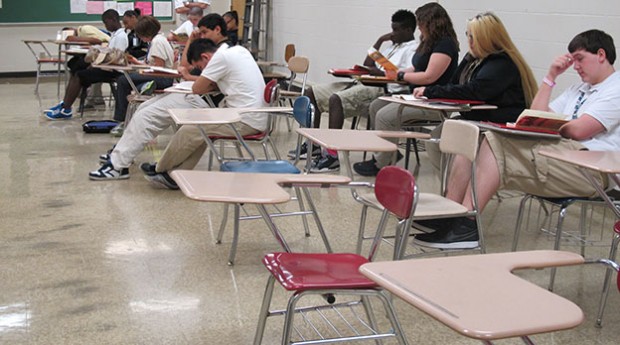Why It Matters Who Shows Up To School

Kyle Stokes / StateImpact Indiana
A few desks sit empty in a classroom on one of the last days of school at T.C. Howe High School in Indianapolis in June.
“What do you think the number one problem has been in terms of high school in this building for us to be successful?” Indianapolis teacher Kevin Sandorf asked during an interview with StateImpact last month.
A salient question — Sandorf taught ninth grade English at T.C. Howe High School, one of the five Indiana schools tapped for state takeover in the upcoming school year.
“It’s attendance. It’s attendance,” Sandorf said immediately, answering his own question. “Look at the data on attendance, and that is a screaming piece.”
A report released Wednesday shows just how right Sandorf is, demonstrating how students who are chronically absent — even middle-level grades — greatly reduce their likelihood of graduating from high school. IU’s Center for Evaluation and Education Policy conducted the study at the urging of The Indiana Partnerships Center. The report calls on policymakers to make more reliable data available so schools can intervene with students who aren’t showing up to classes.
The study highlights how chronic absenteeism can be an indicator of trouble, even in the early grades. According to CEEP’s analysis, barely one-quarter of students in Grades 6-8 who missed 18 days of school or more per year went on to graduate from high school.
“We know that kids who fall behind in those early grade levels are going to have a hard time catching up later, so there is long-term impact throughout K-12 education,” Terry Spradlin, the report’s lead author, said in a statement. “If kids are falling behind in kindergarten or first grade because of being absent and they’re not developing good literacy skills, that can signify long-term challenges for them.”
A few assorted findings excerpted from the report:
- “Approximately 88% of students with good attendance (missing fewer than five days) throughout high school graduated, compared to 24% of students who missed 18 or more days on average per school year.”
- “In grade 3, students who were chronically absent scored nearly 50 scale score points lower on the Math portion of ISTEP+ than same-age peers who missed fewer than five days.”
- “Problematic attendance in Indiana is associated with higher levels of poverty… Indiana schools with higher percentages of students receiving FRL [free or reduced price lunch] had lower average daily attendance rates. An exemplary or good average daily attendance standing for schools is associated with lower percentages of the complexity factors of FRL, Special Education, and Limited English Proficient students, while poor or very poor attendance rates among schools are associated with the highest percentages of those factors.”